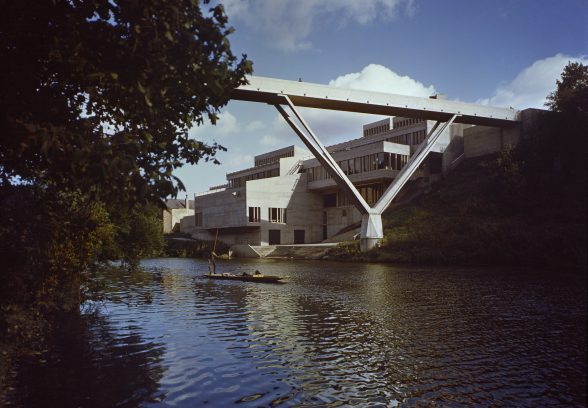This website uses cookies
This website uses cookies to enable it to function properly and to analyse how the website is used. Please click 'Close' to accept and continue using the website.



A crowdfunding campaign has been launched to save Dunelm House, the Brutalist student union building in Durham, providing a platform for the discussion of ideas about alternative uses for the building and options for reuse and adaptation rather than demolition.
Led by the Save Dunelm House Team and supported by the C20 Society and Newcastle University School of Architecture, Planning and Landscape, the campaign will involve a design charrette, to be held early next year, to test and develop alternative futures for Dunelm House. This will involve teams of architects, students and engineers from some of the UK’s best practices working on different ideas for the adaptation and refurbishment of the building. The C20 Society will be helping to organise this.
The crowdfunder will help support an exhibition on the outcome of the charrette in Durham and Newcastle to increase public interest in the debate and the future of Dunelm House A website and publication are also planned.
Following two failed attempts by Historic England and the C20 Society to get the building listed, the Department for Culture, Media and Sport (DCMS) has once again upheld its support for Durham University’s application for a Certificate of Immunity from Listing (COIL). This would prevent Dunelm House from being listed for 5 years and paves the way for the University to demolish the building. This is currently being appealed by the C20 Society.
Project organiser James Perry says that ‘the charrette aims to fill in the gaps between the desire of the Students’ Union to no longer be based in Dunelm House, and Durham University’s decision to pursue demolition. There are a number of steps missing in reaching that conclusion which we aim to challenge it by drawing together the expertise of designers, historians and engineers’.
He added: “Like all good buildings, Dunelm House is in dire need of long term investment, not short term, ad-hoc fixes and least of all demolition. I would say as an architect we need to be looking to reuse, recycle, extend or adapt our buildings rather than disposing of them because we don’t like the way they look.”
Clare Price, Senior Conservation Adviser with C20 Society, said: “We are of the opinion that the issues are ones of repair and that they can be addressed. Many buildings of this period, listed and unlisted, suffer from problems with concrete, often caused by lack of maintenance or inappropriate repairs. These issues have successfully been resolved in numerous cases.”
The five-level concrete building was constructed between 1964 and 1966 by the river Wear to the designs of Richard Raines of the Architects’ Co-Partnership, under supervision of the partner Michael Powers. It connects to Ove Arup’s Grade I-listed Kingsgate Bridge, which was constructed four years earlier. Arup acted as structural engineer and architectural advisor and is famously featured in a bust on one of the outside walls.
In addition to winning both a Civic Trust award and the RIBA Bronze Medal for 1966, the building was positively reviewed at the time of its completion and has subsequently been praised many times. Architectural historian Nikolaus Pevsner called the block ’Brutalist by tradition but not brutal to the landscape… the elements, though bold, [are] sensitively composed’.
The considerable support for the building was evident at the Caring for Brutalism event organised jointly by Durham University Centre for Visual Arts and Culture, Durham City Trust in October. Barnabas Calder of Liverpool University summed up the mood of the day by saying “It would be an act of vandalism and short sightedness to demolish this building: don’t do it!”
You can support the Crowdfunding campaign here: https://www.crowdfunder.co.uk/save-dunelm-house-donate

Become a C20 member today and help save our modern design heritage.